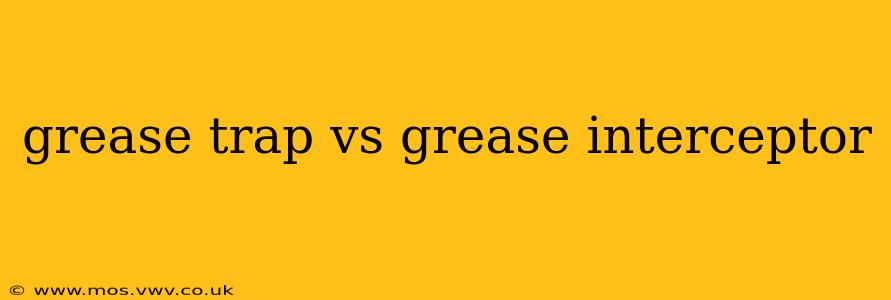Choosing between a grease trap and a grease interceptor can be confusing, especially since the terms are often used interchangeably. However, there are key distinctions between these two crucial components of commercial kitchen plumbing. Understanding these differences is vital for ensuring compliance with regulations and preventing costly plumbing issues. This comprehensive guide will clarify the nuances, helping you make the right choice for your needs.
What is a Grease Trap?
A grease trap is a relatively simple device designed to separate grease and oil from wastewater. It's typically a tank or chamber where wastewater flows slowly, allowing heavier grease and oil to settle to the bottom. This separation prevents grease from clogging pipes and causing backups further down the line. Grease traps are commonly found in smaller establishments with lower wastewater volumes. They are often less efficient than grease interceptors and may require more frequent cleaning.
What is a Grease Interceptor?
Grease interceptors, on the other hand, are more sophisticated and robust systems designed for higher-volume wastewater streams. They utilize various methods, such as baffling and flow control, to efficiently separate grease and oil from wastewater. These advanced systems are more effective at removing grease and are often required by local regulations for larger commercial kitchens, restaurants, and food processing facilities. Grease interceptors are designed for larger volumes of wastewater and offer a higher degree of grease separation compared to grease traps.
What are the Key Differences Between a Grease Trap and a Grease Interceptor?
The main differences lie in their size, efficiency, and regulatory requirements:
-
Size and Capacity: Grease traps are generally smaller and less complex, suitable for smaller establishments with lower wastewater flow rates. Grease interceptors are significantly larger and more complex to accommodate higher volumes of wastewater.
-
Efficiency: Grease interceptors are more efficient at separating grease and oil from wastewater compared to grease traps. Their design and mechanisms lead to a higher removal rate, minimizing the risk of clogs and environmental pollution.
-
Regulatory Compliance: Local building codes and health regulations often mandate the use of grease interceptors for larger commercial kitchens. The specific requirements vary by location, but generally, businesses exceeding a certain wastewater volume or type of operation must install a grease interceptor.
-
Maintenance: Both require regular maintenance, including cleaning and emptying. However, due to their larger capacity and higher efficiency, grease interceptors might require less frequent cleaning than grease traps.
What Size Grease Trap or Interceptor Do I Need?
The size and type of grease management system needed depends on several factors, including:
-
Volume of wastewater produced: The amount of wastewater generated daily significantly impacts the size required.
-
Type of food establishment: Different types of food service operations (e.g., fast-food restaurants, fine dining) generate different volumes and types of grease.
-
Local regulations: Local codes and regulations dictate the minimum size and type of grease management system allowed.
It's crucial to consult with a licensed plumber or plumbing engineer to determine the appropriate size and type of grease trap or interceptor for your specific needs and to ensure compliance with local regulations. Improper sizing can lead to inefficient grease removal, causing backups and potential environmental issues.
How Often Should I Clean My Grease Trap or Interceptor?
The frequency of cleaning depends on factors such as the size of the unit, the volume of wastewater, and the type of food prepared. Regular inspections and professional cleaning are essential to maintain optimal performance and prevent clogs. A schedule should be established based on recommendations from your plumber or local health authority.
What Happens if I Don't Maintain My Grease Trap or Interceptor Properly?
Neglecting proper maintenance of your grease trap or interceptor can lead to several serious problems:
-
Clogged pipes and backups: Accumulated grease can cause significant clogs in the drainage system, resulting in costly repairs and potentially disrupting business operations.
-
Environmental pollution: Grease discharged into the sewer system can contaminate waterways and harm aquatic life.
-
Health code violations: Failure to maintain a properly functioning grease trap or interceptor can result in health code violations and penalties.
By understanding the differences between grease traps and grease interceptors and adhering to proper maintenance schedules, you can ensure efficient grease management, prevent plumbing problems, and maintain compliance with all relevant regulations. Remember, consulting with a professional is crucial for selecting and maintaining the appropriate system for your specific needs.
